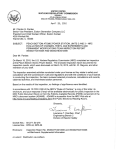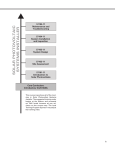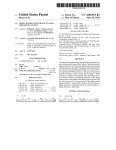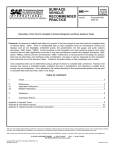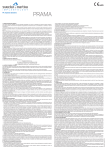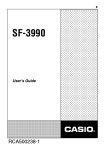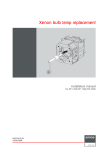Download HP TextEngineer Technical Writing Guide User's Manual
Transcript
Company Writer's Guide SECTION 1 STYLE GUIDE This section of the Writer’s Guide is intended to establish a basic writing style that is clear, concise, and consistent in presentation of information. Technical information requires more stringent standardization than is common in general usage. Therefore, generating a deliverable to accommodate an expeditious technical review requires avoiding confusing or ambiguous statements and unnecessarily verbose descriptions. 1.1 WRITING STYLE APPROACH Avoid use of colloquialisms in writing. Terms like “putting your best foot forward” or “cutting to the quick” can be misunderstood by international customers and lead to confusion. Conversational English is inappropriate for formal business and technical writing. Keep language clear and precise. The following guidelines will help improve your writing and allow us to present a standardized “look and feel” in deliverables to customers. Great Content, Economically Delivered The most effective technical writing is taut, information-rich material that easily conveys the most important points. Here are some ways you can achieve this. 1. Try to restrict acronym use to the five to ten most important acronyms in a subject area and write out the secondary or peripheral terms. 2. Always write in a simple and direct style by avoiding: • • • • Wordiness (examples of wordiness appear in Table 1.1-1) Strings of adjectives Puffery (Our company is uniquely qualified ...) Phrases and words that obscure the central meaning, for example: Wrong: The system is designed such that active components are capable of being tested during plant operation. Right: The active components can be tested during plant operation. [For Illustration Only] 1-1 Company Writer's Guide Table 1.1-1. Examples of Wordiness Verbose-ese Equivalent by means of by connect together connect, join consider all factors carefully consider due to the fact that because for the purpose of for, to furthermore it would seem and give proper consideration to consider has a tendency to tends in addition to also initiate action start in order to to in spite of the fact that though/although in the case in which when in the event that if in this instance, however but is capable of/has the ability to can situated placed, sits, lies termination end used to fulfill needed utilize use warrant the use of must or should have, require [For Illustration Only] 1-2 Company Writer's Guide 3. Make sure that your graphics clearly support information in the text. Have you chosen the most illustrative graphics in each section? Is there a difficult passage of text that you could elucidate with a figure? Verb Tenses As a general rule, use the present tense. For example, “our design includes” (not “will include” or “included”); “our Project Team is ready” (not “will be ready”). However, use future tense when describing project activities still to be performed. Also, use future tense in outline revisions when describing what completed sections will contain. Use past tense when discussing completed project activities, observations from walkdowns, and the results of studies and tests already performed. “The controls analysis showed that…” Active versus Passive Voice Use active voice to raise impact. Examples include: Passive: Procedures were initiated to reduce plant accidents. Active: The company initiated procedures to reduce plant accidents. Passive voice is acceptable, and is used often in customer documents, in a particular situation – when the object in the sentence must have emphasis over the subject. Example: The Quality Plan must be followed by all subcontractors. Additional Guidance 1. Avoid pathetic fallacy, that is, giving inanimate objects actions or responsibilities. Examples include: • The Management Plan ensures . . . (a plan cannot ensure) • The program is enjoying success . . . (a program cannot enjoy) • The site must consider . . . (a site cannot consider) 2. The word “comprise” means to include or to be made up of. A large entity cannot “be comprised of” smaller things. It comprises them. [For Illustration Only] 1-3 Company Writer's Guide 3. Be assertive in your writing. Examples include: • Use “will” not “may,” “plan to,” or “would.” Use “plan” only as a noun or in the strict sense of planning and scheduling. • Use “shall” only in discussing project or regulatory requirements. • Use “ensure,” not “insure.” “Assure” is not as forceful as “ensure.” However, use “assure” in quality assurance discussions. 4. Avoid a tutorial writing style. “First one must . . . then one does . . . and after these steps, one logically progresses to. . .” 5. Be consistent with terminology. Use terms as agreed with the customer in commercial agreements and elsewhere. Defer to customer terminology, not ours. 1.2 ABBREVIATIONS, ACRONYMS, TRADEMARKS, AND SYMBOLS Abbreviations, acronyms, trademarks, and symbols should be consistent throughout the deliverables and consistent with generally accepted usage. Acronyms should be used sparingly in the text, particularly in international projects. Acronyms are used in parentheses following the spelled-out form in the first reference. A team may produce a list of the most common acronyms for their project. Appendix A contains the most commonly used trademark references. Initial uses of trademarked names appear with “®” or “™” as appropriate. Appendix B provides a list of company-approved abbreviations and symbols. Use only those abbreviations, acronyms, or symbols that are common in our industry and that are defined. When using “a” or “an” before an abbreviation or acronym, make sure that the article agrees with the initial sound of the term as it is normally pronounced. The article “a” precedes a consonant sound, and “an” precedes a vowel sound. [For Illustration Only] 1-4 Company Writer's Guide In text, use the word form of common abbreviations such as percent, degree, number, equal to, plus, minus, less than, greater than, and the like. Symbols should be used in the following cases: • For temperatures given with a numerical value, use the degree symbol (32°C, etc.). • For equations, either written in-line with the text or displayed (standing alone), use symbols. • In graphics (figures and tables), use symbols if space is a problem. The use of symbols in text should be avoided in most cases. Write out phrases to ensure clarity. For example, use “greater than” instead of “>.” The following generally accepted symbols may be used: • • • • Delta Degrees Celsius Degrees Fahrenheit Plus or minus Δ °C °F ± The following symbols should be avoided, but may be used when necessary, such as in tables and figures, to save space: • • • • • • • • • • • • Equal to Approximately Greater than Less than Greater than or equal to Less than or equal to Inches Feet Number Plus Minus And [For Illustration Only] = ∼ > < ≥ < " ' # + & 1-5 Company Writer's Guide 1.3 PUNCTUATION 1 Standard rules of English (as defined by Strunk and White ) for grammar and punctuation should be used. Avoid long sentences; use semicolons (;) only in short sentences. Also, avoid using contractions because they often cause confusion. Use the final comma in a series (e.g., apples, oranges, and pears). Place periods after the following: • • Sentences Between heading digits (e.g., 1.1.1) and after lower-level step letters and numbers (e.g., a., 1.) Place colons after statements that are followed by lists, such as lists of individual components. • 1.4 Bullets (•) should be used in a list instead of numbers or letters when numbering serves no purpose, or no reference to specific item(s) in the list will be made. CAPITALIZATION The trend in most corporate and technical writing is to eliminate unnecessary capitalization. Use capitalization only as described below. Capitalize the first letter of the following: • • • • • • 1 Each main word in subsection headings First word in a sentence First word in each phrase used in a list Proper nouns, such as vendor or organization names Full titles of formal programs and documents Specific company product names Strunk, William, and E. B. White, “The Elements of Style.” [For Illustration Only] 1-6 Company Writer's Guide Capitalize all letters in each of the following: • • Main section headings Acronyms, initialisms Do not capitalize: • Generic product and component names (for example, controller, panel, switch) • Generic system names • Acronym definitions (unless they belong in the above initial-cap group) Capitalize the first letter of Government, Division, Plant, Project, etc., when referring to a specific one. Use lower case when it is only a general reference. 1.5 NUMERALS AND UNITS Both Arabic and Roman numerals may be used in company documents. General guidelines for proper use are the following: • • • • Express safety class and quality group in Arabic numerals (1, 2, 3). Express seismic category in Roman numerals (I, II, III). Express electrical Class 1E in Arabic (not IE).2 Express steps in a process in Arabic. Use Arabic numerals unless specific nomenclature dictates otherwise (and with lower-case Roman numerals for table of contents, list of figures, etc.). Avoid spelling out large numbers unless nomenclature dictates it. Spell out integers less than 10 that do not apply to a specific measurement (e.g., two procedures, 2 inches). Use commas in fourdigit or larger numbers (except in hexadecimal numbers). Be consistent in using units of measure. European customers require metric units of measure. Preferred presentation of measurements in European projects is: metric or SI (followed by English in parentheses). Normally, in text, use written-out units. Exception: electrical units – V, A, Hz. Abbreviate other units in tables and where space is limited. [For Illustration Only] 1-7 Company Writer's Guide When a spelled-out unit of measurement is used with a quantity, use the singular or plural form of the unit of measurement based on the following criteria: • If the quantity is the unit 1 or a fraction of 1, use the singular form of the spelled-out unit of measurement. Examples: — 0.6 meter — 1/32 inch — 1 second • If the quantity is zero or more than the unit 1, use the plural form of the spelled-out unit of measurement. Examples: — 0 inches — 1.6 meters — 3-1/2 millimeters — 8 seconds • Remember, however, that the singular form of an abbreviated unit of measurement is used also for the plural and modified forms. Examples: — 0 VDC — 3.5 m — 8 s interval 1.6 REFERENCES There are many accepted models for writing references, each appropriate for a given class of documents (from scholarly works to popular periodicals). We present a conventional approach that has worked well for most projects. Applying these simple rules will help us standardize reference lists. 1. The usual sequence for entering a company document in a reference list is document number, followed by the title in quotes, revision number (if applicable), then issuing unit, and date. There are subtle variations depending on the type of document. [For Illustration Only] 1-8 Company Writer's Guide When listing project-specific documents, follow this example. Document number, ABC Project, “XYZ System General Requirements,” Business Unit, date. Note It is not necessary to give the revision level of project documents unless there is a specific reason to cite an earlier revision. The most recent revision at the time of issuance applies. 2. For standards and regulatory guidance, the form is number, title in quotes, revision (if applicable), issuing body, and date (if applicable). 3. External, published works are handled as follows: • Author’s last name, comma, first initial, comma. Additional names in normal order (first initial, last name), period. • Title of book, article, or paper, period. • Title of journal or larger work in italics, comma. • Volume and number information, if applicable, period. • City, colon, publishing body, (if applicable), period. • Date, period. Examples of published works: Adams, M. J., Y. J. Tenney, and R. W. Pew. Situation Awareness and the Cognitive Management of Complex Systems. Human Factors, 37, 85-104. 1995. Brannick, M. T., E. Salas, and C. Prince. Team Performance Assessment and Measurement. Mahway, NJ: Lawrence Erlbaum Associates. 1997. Cannon-Bowers, J. A. and E. Salas. Making Decisions Under Stress: Implications for Individual and Team Training. Washington, D. C.: American Psychological Association. 1998. 4. Manual titles are usually underlined. [For Illustration Only] 1-9 Company Writer's Guide 5. The ordering of documents in the reference list should correspond to the sequence of references used in the document, so that Reference 1 is the first one used, 2 the second, and so on. 6. Reference callouts may be of two types. “This methodology is explained thoroughly in Reference 7…” OR “As was concluded in the Recorder Review (Ref. 2),…” 1.7 GRAPHICS Figures, tables, photos, and charts are all considered graphics. Figures, photos, and charts will be assigned figure numbers. Tables will be assigned table numbers. When using graphics, observe the following: 1.8 • Cite all graphics in text, with corresponding numbers. • Number in sequence by second-level section — Figure 1.1-1 is the first figure cited in Section 1.1; Table 1.1-1 is the first table cited in Section 1.1, etc. If a graphic is cited in the text of a top-level section, the numbering is 1-1, 1-2, etc. • Capitalize the initial letter of the words “figure” and “table” when they appear with a number; otherwise, use lower case (the figure shows the difference between . . .). EDITING CONVENTIONS Many words and phrases can be written more than one way. Every project should use the broad list of writing conventions (preferred terms, spellings, punctuation) in this section, and define additional conventions as needed, to promote consistency among documents. In the list, when a phrase is to be hyphenated in adjectival use as a unit modifier (um), that note accompanies the phrase. Other abbreviations in the list include (n) for noun and (v) for verb. While this may be useful for reference, engineering authors should not spend precious time worrying about these details. [For Illustration Only] 1-10 Company Writer's Guide AC deadman air flow deadweight Alloy 750 decision-making (um) around-the-clock (um) decision-set (um) ASME Code de-energize B.S., M.S. diesel-generator (um) backfit double check (v, n, um) backflow driveline backlit E-C (engineer-constructor) backpressure electromechanical backup e-mail best-estimate (um) employee boil-off (n, um) ensure (not insure) break-even (um) entry level Btu Environmental, Safety, and Health buildup ES and H built-in (um) et al. buses etc. bypass fail-closed (um) carbon steel (n, um) failover centerline feedback changeout fiber-optic (um) close-up flow path closeout flow rate coauthored followup common-mode (um) foot constructibility foreword cooldown (n/um) freestanding cooperate front-line (um) cost-effective (um) full-penetration (um) creep-down (um) full-scope (um) crossover full-time (um) cutset FY 2002 database ground-level (um) datalink groundwater DC handhole [For Illustration Only] 1-11 Company Writer's Guide hard-copy (um) low-pressure (um) hard-face (um) makeup hard rock (um) make-or-buy (um) hard-wired man-hours heatup (um) manway high-build (um) mid-size (um) high-energy (um) mockup high-level (um) multicompany hold-down (um) multimillion holdup Navy hot-dip (um) nil-ductility human-factor (um) no-load (um) in-depth (um) non-Class 1E in-flow (um) non-conformance in-house (um) non-exempt in-leakage (um) non-process in-service (um) offeror inside diameter offgas in-situ (um) off-line (um) in-tank (um) off-load interrelated offset January 2002 offsite kV onboard large-scale (um) on-call (um) latch-locking (um) on-line (um) layout on-schedule (um) leak-off (n, um) one-half (all cases) leaktight ongoing leaktightness onset lifetime onsite lift-off (n, um) outside diameter locked-closed (um) overwrite log-normal (um) partial-penetration (um) long-lead (um) pathway longstanding percent low-level (um) pinhole [For Illustration Only] 1-12 Company Writer's Guide post-heat time-out post-test Title II preheat topcoat preoperational trade-off (n, um) pre-procurement two-dimensional (um) pre-service (um) Type 304 proactive Type A pushbutton U.S. (um) read-out (n, um) unisolatable real-time (um) United States (n) record-keeping (um) up-front (um) remote-handled (um) VAC roundtable VDC self-sufficient (um) versus set point videodisk shear wave (um) videotape shutdown walkdown sign-off (n, um) warmup socioeconomic water-reducing (um) soil-structure (um) watertight stand-alone wave-front (um) standup work-around (n, um) startup work scope state-of-the-art (um) workday Statement of Work workstation subassembly world-class (um) subunit ." thousand ±0.5 through-wall (um) 1990s time-history (um) Notes: 1. Certain compound or joined words may become two words when used as a verb. Example: We will start up the process next month. 2. Certain words are hyphenated when they are adjectives (unit modifiers), but not when they stand alone. Example: The computer is off line. [For Illustration Only] 1-13 Company Writer's Guide APPENDIX A COMMONLY USED TRADEMARKS The first use of a trademark name should include “®” or “™” as appropriate. The following are the most often-used trademarks in our business as they should appear under “Acronyms and Trademarks” in the front matter. [“Adobe” and “the Adobe logo” first, if used, followed by other Adobe marks used in alphabetical order] are either registered trademarks or trademarks of Adobe Systems Incorporated in the United States and/or other countries. Autodesk, AutoCAD, and Autodesk Inventor are either registered trademarks or trademarks of Autodesk, Inc., in the USA and/or other countries. All other brand names, product names, or trademarks belong to their respective holders. Cisco® is a registered trademark of Cisco Systems, Incorporated. DEC™ is a trademark of Digital Equipment Corporation. Diamond Plus® is a registered trademark of Mitsubishi Electronics America, Incorporated. EIMaster Power Concept® is a registered of Sigma Power Software AB. Energy Star® is a U.S. registered trademark. Intel® and Pentium® are registered trademarks of Intel Corporation. LaserJet™, JetAdmin™, and HP9000™ [and other printer models] are trademarks of HewlettPackard Company. Microsoft, Encarta, MSN, and Windows are either registered trademarks or trademarks of Microsoft Corporation in the United States and/or other countries. Motif, OSF/1, UNIX and the “X” device are registered trademarks, and Making Standards Work and The Open Group are trademarks of The Open Group in the US and other countries. MultiSync® and FE+™ are trademarks of NEC-Mitsubishi Electronic Display of America, Incorporated. [For Illustration Only] A-1 Company Writer's Guide Netscape and the Netscape N and Ship's Wheel logos are registered trademarks of Netscape Communications Corporation in the U. S. and other countries. [List other Netscape product names used in your document] are also trademarks of Netscape Communications Corporation and may be registered outside the U.S. Oracle® is a registered trademark of Oracle Corporation. Primavera Project Planner® is a registered trademark of Primavera Systems, Incorporated. SAP/R3™ is a trademark of SAP AG Corporation. ServSwitch™ is a trademark of Black Box Corporation. SPARC® is a registered trademark of SPARC International, Incorporated. Sun™, Sun Microsystems™, Sun Enterprise™, Ultra™, UltraSPARC™, Solstice™, StorEdge™, Solaris ™, Java ™, all Sun, Solaris, Java, formative trademarks and logos are trademarks or registered trademarks of Sun Microsystems, Incorporated in the United States and other countries. [For Illustration Only] A-2 Company Writer's Guide APPENDIX B ABBREVIATIONS AND SYMBOLS Abbreviations facilitate reading and minimize dull repetition of cumbersome names. Abbreviations should be used only when necessary and when their meanings are unquestionably clear. When in doubt, spell it out. In the text, capitalization will agree with the parent word. Rules of capitalization apply. The same abbreviation should be used for all tenses, possessive, singular, and plural. A sentence should never begin with an abbreviation except where the parent word(s) would result in an awkward construction. The following pages contain basic rules to use when abbreviating, and a list of engineering unit abbreviations in their proper form. 1. Abbreviations should be spelled out in all possible circumstances. However, when abbreviations are necessary, use the following guidelines: a. The trend is to omit periods from all abbreviations except where they have traditionally appeared (for example, U.S., Ph.D., Mr., Mrs.). b. There should be no space after the internal periods within a traditional abbreviation (for example, a.m., U.S., i.e., etc.). c. An abbreviation needs no period unless it can be confused with a word (e.g., in., a.m., no.,). One exception to this rule is a period usually is not necessary in tabular material. 2. The following common Latin abbreviations should appear as: i.e., (that is) e.g., (for example) et al., (and others) etc., (and so forth) A comma should precede and follow the above abbreviations when used in the middle of a sentence. 3. “versus” should be spelled out, not “vs.” [For Illustration Only] B-1 Company Writer's Guide 4. When using unit abbreviations such as Btu, kW, Hz. . . a space should be placed between the number and the abbreviation. e.g.; 100 Btu, 3 kW, 50 Hz. 5. Refrain from using the symbols " and ' for inches and feet unless referring to a plant elevation or when it is necessary to save space (i.e., within tables, forms, etc.). However, use inches and feet in their proper forms as follows: 0.5 inch of space around the margin (singular) 2 inches in diameter (plural) a 3-inch circle (used as an adjective and therefore hyphenated) 6. Below are a few commonly used abbreviations in their proper form: Type 316 SS (notice the cap T and the space between 316 and SS) 2-1/4 Cr-1 Mo E-953011 (hyphen after the E) 7. Do not abbreviate the company name in text except as part of abbreviations of subsidiary or joint venture names. 8. For equipment names used repeatedly in text, spell it out the first time, with the abbreviation in parentheses following the name. Subsequent references can then be made by the abbreviation alone. Also note that if a control name printed on the equipment is abbreviated, it should be repeated exactly, including capitalization, when cited in the text. Plurals of Abbreviations 1. Abbreviations in units of measure are identical in their singular and plural forms (e.g., 10 lb not 10 lbs). 2. Acronyms, letters, and numbers are made plural by adding “s” alone: the three Rs in twos and threes LPRs the early 1970s SDDs [For Illustration Only] B-2 Company Writer's Guide 3. Abbreviations with periods, lower-case letters used as nouns, and capital letters that would form another word if “s” alone were added form the plural with an apostrophe and an “s”: Ph.D.’s x’s and y’s S’s, A’s, I’s Letter Symbols for Units of Measurement The following pages are taken from Corporate Standards. These abbreviations should be the only ones used unless stated otherwise in a project-specific document. [For Illustration Only] B-3 Company Writer's Guide Symbols for Units in General Use Unit Symbol Notes ampere A SI unit of electric current. ampere (turn) A SI unit of magnetomotive force. ampere-hour Ah Also A•h ampere per meter A/m SI unit of magnetic field strength. angstrom Δ 1 Δ = 10 m (deprecated, see ANSI Z210.1-1976) atmosphere, standard atm 1 atm = 101 325 Pa (deprecated, see ANSI Z210.11976) atmosphere, technical at 1 at = 1 kgf/cm2 (deprecated, see ANSI Z210.1-1976) atomic mass unit (unified) u The (unified) atomic mass unit is defined as one twelfth of the mass of an atom of the 12C nuclide. Use of the old atomic mass (amu), defined by reference to oxygen, is deprecated. atto a SI prefix for 10-18. attoampere aA bar bar 1 bar = 100 kPa. Use of the bar is strongly discouraged (see ANSI Z210.1-1976), except for limited use in meteorology. barn b 1 b = 10-28 m2 barrel bbl 1 bbl = 42 galUS = 158.99 L barrel per day bbl/d This is the standard barrel used for petroleum, etc. A different standard barrel is used for fruits, vegetables, and dry commodities. baud Bd In telecommunications, a unit of signaling speed equal to one element per second. The signaling speed in bauds is equal to the reciprocal of the signal element length in seconds. [For Illustration Only] -10 B-4 Company Writer's Guide Symbols for Units in General Use (Cont’d) Unit Symbol Notes bel B becquerel Bq SI unit of activity of a radionuclide. billion electronvolts GeV The name gigaelectronvolt is preferred for this unit. bit b In information theory, the bit is a unit of information content equal to the information content of a message the a priori probability of which is one half. In computer science, the bit is a unit of storage capacity. The capacity, in bits, of a storage device is the logarithm to the base two of the number of possible states of the device. bit per second b/s British thermal unit Btu calorie (International Table calorie) calIT 1 calIT = 4.1868 J (deprecated, see ANSI Z210.11976) calorie (thermochemical calorie) cal 1 cal = 4.1840 J (deprecated, see ANSI Z210.1-1976) candela cd SI unit of luminous intensity. candela per square inch cd/in2 Use of the SI unit, cd/m2, is preferred. candela per square meter cd/m2 SI unit of luminance. The name nit is sometimes used for this unit. candle cd The unit of luminous intensity has been given the name candela; use of the name candle for this unit is deprecated. centi c SI prefix for 10-2. centimeter cm [For Illustration Only] B-5 Company Writer's Guide Symbols for Units in General Use (Cont’d) Unit Symbol Notes centipoise cP 1 cP = 1 mPa • s. The name is deprecated (see ANSI Z210.1-1976). centistokes cSt 1 cst = 1 mm2/s. The name centistokes is deprecated (see ANSI Z210.1-1976). circular mil cmil 1 cmil = (Π/4) • 10-6 in2 coulomb C SI unit of electric charge. cubic centimeter cm cubic foot ft3 cubic foot per minute ft3/min cubic foot per second ft /s cubic inch in3 cubic meter m3 cubic meter per second m3/s cubic yard yd curie Ci cycle c cycle per second Hz, c/s [For Illustration Only] 3 3 3 A unit of activity of radionuclide. Use of the SI unit, the becquerel, is preferred, 1 Ci = 3.7 x 1010 Bq. See hertz. The name hertz is internationally accepted for this unit; the symbol Hz is preferred to c/s. B-6 Company Writer's Guide Symbols for Units in General Use (Cont’d) Unit darcy Symbol D Notes 1 D = 1 cP (cm/s) (cm/atm) = 0.986 923 μm 2 A unit of permeability of a porous medium. By traditional definition, a permeability of one 3 darcy will permit a flow of 1 cm /s of fluid of 1 cP viscosity through an area of 1 cm2 under a pressure gradient of 1 atm/cm. For nonprecision work 1 D may be taken equal to 1 μm2 and 1 mD equal to 0.001 μm2. Deprecated (see ANSI Z210.1-1976). day d deci d decibel dB degree (plane angle) ...° -1 SI prefix for 10 . degree (temperature): degree Celsius °C SI unit of Celsius temperature. The degree Celsius is a special name for the kelvin, for use in expressing Celsius temperatures or temperature intervals. degree Fahrenheit °F Note that the symbols for °C, °F, and °R comprise two elements, written with no space between the ° and the letter that follows. The two elements that make the complete symbol are not to be separated. degree Kelvin degree Rankine See kelvin. °R deka da SI prefix for 10. dyne dyn Deprecated (see ANSI Z210.1-1976). electronvolt eV erg erg [For Illustration Only] Deprecated (see ANSI Z210.1-1976). B-7 Company Writer's Guide Symbols for Units in General Use (Cont’d) Unit Symbol Notes 16 exa E SI prefix for 10 . farad F SI unit of capacitance. fem to f SI prefix for 10-15. femtometer fm foot ft conventional foot of water ftH2O 1 ftH2O = 2989.1 Pa (ISO) foot per minute ft/min foot per second ft/s foot per second squared ft/s foot pound-force ft-lbf footcandle fc 1 fc = 1 lm/ft2. The name lumen per square foot is also used for this unit. Use of the SI unit of illuminance, the lux (lumen per square meter), is preferred. footlambert fL 1 fL . 1/Π) cd/ft2. A unit of luminance. One lumen per square foot leaves a surface whose luminance is one footlambert in all directions within a hemisphere. Use of the SI unit, the candela per square meter, is preferred. gal Gal 1 Gal = 1 cm/s2 (deprecated, see ANSI Z210.1 1976). gallon gal 1 galUK = 4.5461 L 2 3 1 galUS = 231 in = 3.7854 L gauss G The gauss is the electromagnetic CGS unit of magnetic flux density. Deprecated (see ANSI Z210.1-1976). giga G SI prefix for 10 . [For Illustration Only] 9 B-8 Company Writer's Guide Symbols for Units in General Use (Cont’d) Unit Symbol Notes gigaelectronvolt GeV gigahertz GHz gilbert Gb grain gr gram g gram per cubic centimeter g/cm3 gray Gy SI unit of absorbed dose in the field of radiation dosimetry. hecto h SI prefix for 102. henry H SI unit of inductance. hertz Hz SI unit of frequency. horsepower hp The horsepower is an anachronism in science and technology. Use of the SI unit of power, the watt, is preferred. hour h inch in. The gilbert is the electromagnetic CGS unit of magnetomotive force. Deprecated (see ANSI Z210.1-1976). conventional inch of mercury inHg 1 inHg = 3386.4 Pa (ISO) conventional inch of water inH2O 1 inH2O = 249.09 Pa (ISO) inch per second in/s joule J SI unit of energy, work, quantity of heat. joule per kelvin J/K SI unit of heat capacity and entropy. kelvin K In 1967, the CGPM gave the name kelvin to the SI unit of temperature which had formerly been [For Illustration Only] B-9 Company Writer's Guide Symbols for Units in General Use (Cont’d) Unit Symbol Notes called degree kelvin and assigned it the symbol K (without the symbol °). kilo k SI prefix for 103. kilogauss kG Deprecated (see ANSI Z210.1-1976). kilogram kg SI unit of mass. kilogram-force kgf Deprecated (see ANSI Z210.1-1976). In some countries, the name kilopond (kp) has been used for this unit. kilohertz kHz kilohm kΩ kilometer km kilometer per hour km/h kilopound-force klbf kilovar kvar kilovolt kV kilovoltampere kVA kilowatt kW kilowatthour kWh Also kW•h knot kn 1 kn = 1 nmi/h lambert L 1 L = (1/Π) cd/cm2. A CGS unit of luminance. One lumen per square centimeter leaves a surface whose luminance is one lambert in all directions within a hemisphere. Deprecated (see ANSI Z210.1-1976). [For Illustration Only] Kilopound-force should not be misinterpreted as kilopond (see kilogram-force). B-10 Company Writer's Guide Symbols for Units in General Use (Cont’d) Unit Symbol Notes 1 L = 10-3 m3. The letter symbol l has been adopted for liter by the CGPM, and it is recommended in a number of international standards. In 1978, the CIPM accepted L as an alternative symbol. Because of frequent confusion with the numeral 1, the letter symbol l is no longer recommended for USA use (see Federal Register notice of December 10, 1976). The script letter Ρ, which had been proposed, is not recommended as a symbol for liter. liter L liter per second L/s lumen lm lumen per square foot lm/ft lumen per square meter lm/m2 SI unit of luminous existence. lumen per watt lm/W SI unit of luminous efficacy. lumen second lm•s SI unit of quantity of light. lux lx 1 lx = 1 lm/m SI unit of luminous flux. 2 A unit of illuminance and also a unit of luminous existence. Use of the SI unit, lumen per square meter, is preferred. 2 SI unit of illuminance. maxwell Mx The maxwell is the electromagnetic CGS unit of magnetic flux. Deprecated (see ANSI Z210.1-1976). mega M SI prefix for 106. megaelectronvolt MeV megahertz MHz megohm MΩ meter m [For Illustration Only] SI unit of length. B-11 Company Writer's Guide Symbols for Units in General Use (Cont’d) Unit Symbol Notes metric ton t 1 t = 1,000 kg. The name tonne is used in some countries for this unit, but use of this name in the USA is deprecated (see ANSI Z210.1-1976). mho mho Formerly used as the name of the siemens (S). micro μ SI prefix for 10-6. microampere μA microfarad μF microgram μg microhenry μH microinch μin microliter μL micrometer μm micron μm microsecond μs microwatt μW mil mil 1 mil = 0.001 in. mile (statute) mi 1 mi = 5280 ft mile per hour mi/h Although use of mph as an abbreviation is common, it should not be used as a symbol. milli m SI prefix for 10-3 milliampere mA millibar mbar milligram mg millihenry mH [For Illustration Only] See note for liter. Deprecated. Use micrometer. Use of the bar is strongly discouraged in ANSI Z210.1, except for limited use in meteorology. B-12 Company Writer's Guide Symbols for Units in General Use (Cont’d) Unit Symbol Notes milliliter mL millimeter mm conventional millimeter of mercury mmHg 1 mmHg = 133.322 Pa (deprecated, see ANSI Z210.1-1976). millimicron nm Use of the name millimicron for the nanometer is deprecated. millipascal second mPa•s SI unit-multiple of dynamic viscosity. millisecond ms millivolt mV milliwatt mW minute (plane angle) ...′ minute (time) min Time may also be designated by means of superscripts as in the following example: 9h 46m 30s. mole mol SI unit of amount of substance. month mo nano n nanoampere nA nanofarad nF nanometer nm nanosecond ns nautical mile nmi neper Np newton N newton meter N•m [For Illustration Only] See note for liter. SI prefix for 10-9. 1 nmi = 1852 m SI unit of force. B-13 Company Writer's Guide Symbols for Units in General Use (Cont’d) Unit Symbol newton per square meter N/m nit nt 2 Notes SI unit of pressure or stress, see pascal. 1 nt = 1 cd/m2 The name nit is sometimes given to the SI unit of luminance, the candela per square meter. oersted Oe The oersted is the electromagnetic CGS unit of magnetic field strength. Deprecated (see ANSI Z210.1-1976). ohm Ω SI unit of resistance. ounce (avoirdupois) oz pascal Pa 1 Pa = 1 N/m2 SI unit of pressure or stress. pascal second Pa•s SI unit of dynamic viscosity. peta P SI prefix for 10 phot ph 1 ph = lm/cm2 15 CGS unit of illuminance. Deprecated (see ANSI Z210.1-1976). pico p picofarad pF picowatt pW pint pt -15 SI prefix for 10 . 1 pt (UK) = 0.568 26 L 1 pt (US dry) = 0.550 61 L 1 pt (US liquid) = 0.473 18 L poise P pound lb pound per cubic foot lb/ft3 pound-force lbf [For Illustration Only] Deprecated (see ANSI Z210.1-1976). B-14 Company Writer's Guide Symbols for Units in General Use (Cont’d) Unit Symbol Notes pound-force foot lbf-ft pound-force per square foot lbf/ft2 pound-force per square inch lbf/in2 poundal pdl quart qt 1 qt (UK) = 1.136 5 L 1 qt (US dry) = 1.101 2 L 1 qt (US liquid) = 0.946 35 L rad rd A unit of absorbed dose in the field of radiation dosimetry. Use of the SI unit, the gray, is preferred. 1 rd = 0.01 Gy. radian rad SI unit of plane angle. rem rem A unit of dose equivalent in the field of radiation dosimetry. (Use of the SI unit, the sievert, is preferred. 1 rem = 0.01 Sv) revolution per minute r/min Although use of rpm as an abbreviation is common, it should not be used as a symbol. revolution per second r/s roentgen R second (plane angle) ...′ second (time) s SI unit of time. siemens S 1 S = 1 Ω-1 Although use of the abbreviation psi is common, it should not be used as a symbol. A unit of exposure in the field of radiation dosimetry. SI unit of conductance. The name mho has been used for this unit in the USA. sievert Sv SI unit of dose equivalent in the field of radiation dosimetry. Name adopted by the CIPM in 1978. slug slug 1 slug = 14.5039 kg [For Illustration Only] B-15 Company Writer's Guide Symbols for Units in General Use (Cont’d) Unit Symbol Notes 2 square foot ft square inch in2 square meter m2 square meter per second m2/s SI unit of kinematic viscosity. square millimeter per second mm2/s SI unit-multiple of kinematic viscosity. square yard yd steradian sr SI unit of solid angle. stilb sb 1 sb = 1 cd/cm2 2 A CGS unit of luminance. Deprecated (see ANSI Z210.1-1976). stokes St Deprecated (see ANSI Z210.1-1976). tera T SI prefix for 1012. tesla T 1 T = 1 N/(A•m) = 1 Wb/m2. SI unit of magnetic flux density (magnetic reduction). therm thm 1 thm = 100,000 Btu ton (short) ton 1 ton = 2000 lb ton, metric t 1 t = 1000 kg. The name tonne is used in some countries for this unit, but use of this name in the USA is deprecated (see ANSI Z210.1-1976). (unified) atomic mass unit u The (unified) atomic mass unit is defined as one twelfth of the mass of an atom of the 12C nuclide. Use of the old atomic mass unit (amu), defined by reference to oxygen, is deprecated. var var IEC name and symbol for the SI unit of reactive power. volt V SI unit of voltage. volt per meter V/m SI unit of electric field strength. [For Illustration Only] B-16 Company Writer's Guide Symbols for Units in General Use (Cont’d) Unit Symbol Notes voltampere VA IEC name and symbol for the SI unit of apparent power. watt W SI unit of power. watt per meter kelvin W/(m•K) SI unit of thermal conductivity. watt per steradian W/sr SI unit of radiant intensity. watt per steradian square meter W/(sr•m ) watthour Wh weber Wb 2 SI unit of radiance. Wb = V•s SI unit of magnetic flux. yard yd year a [For Illustration Only] In the English language, generally yr. B-17

































